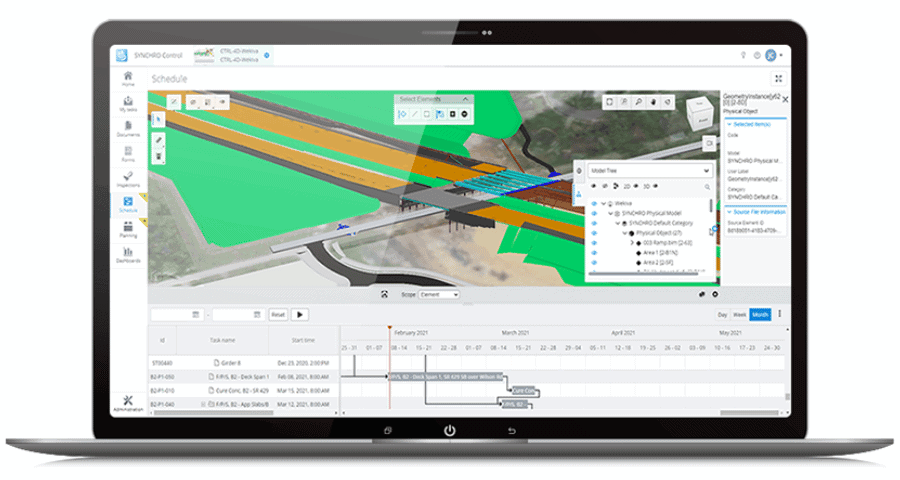Digital Construction Workflows with 3D & 4D BIM
By extending the utility of 3D design models into the construction phase, EPC contractors can better coordinate efforts and expedite the delivery of safer, more sustainable projects.
With global investments in infrastructure on the rise, the heavy civil industry is increasingly adopting 3D/4D digital workflows and collaborative project delivery methods. By extending the utility of 3D design models into the construction phase, EPC contractors can better coordinate efforts and expedite the delivery of safer, more sustainable projects.
Four Strategies to Utilize 3D/4D Digital Workflows
1. Integrate Design and Construction Using 3D Models

Disconnected workflows between design and construction teams highlight the need for 3D/4D model-based processes. Traditionally, design teams convert 3D models into 2D PDFs for construction planning, losing design intent and causing lengthy reviews, costly change orders, and delays.
Adopting 3D/4D workflows and cloud technology transitions project management from a design-centric to a construction-centric approach. This fosters collaboration, coordination, and problem-solving among teams, resulting in better project outcomes. Secure, role-based access ensures data is up-to-date and accessible from various devices.
Integrating design and construction using 3D models enables:
- Clear communication of design intent, enhancing quality and reducing conflicts.
- Streamlined review processes, reducing time by 30% or more.
- Comprehensive project overviews with additional data capture.
- Improved stakeholder visibility, reducing change orders by 15% or more.
2. Virtual Construction Planning with 4D Models

With 60% of health and safety incidents occurring during rework, optimizing project plans, schedules, and resources before starting construction is crucial. Turning 3D design models into 4D construction models achieves this.
4D models allow visualization of the project before building begins. By adding construction equipment and paths to schedule activities, conflicts can be resolved pre-construction. This also aids in understanding the impact on traffic flows and existing rail services. Teams can conduct what-if analyses to enhance safety and minimize risks and delays by reviewing time-lapsed construction sequences.
Simulating construction projects with 3D/4D models before beginning construction helps to:
- Validate and optimize project plans and schedules.
- Anticipate environmental impacts, including traffic and rail services.
- Identify issues early, minimizing construction mistakes and reducing risks.
- Enhance safety planning and regulatory compliance, reducing accidents and injuries.
3. Create Accurate Schedules with Constructible Components

Heavy civil projects often face schedule overruns, significantly affecting costs and community services.
4D workflows break projects into constructible components with auto-calculated quantities, helping build realistic schedules that reflect manpower, material, and other resource needs. This phased approach minimizes community disruption.
By breaking down project elements into constructible components, you can:
- Develop plans that accurately represent project construction.
- Optimize project plans, schedules, and resources.
- Generate precise quantity take-offs to stay on budget and schedule.
- Enhance project transparency, keeping the public informed and compliant with regulations.
4. Automate Field Data Collection and Viewing

Extending the value of 4D models to field workflows enhances status checks, work planning, reviews, and inspections. Connected mobile applications and workflows enable teams to review, validate, and communicate in a comprehensive digital environment that includes documents, forms, and models. This significantly improves project delivery efficiency, including quality, accelerated schedules, and reduced risks, costs, and rework.
By capturing data automatically and electronically in the field, teams can:
- Increase field productivity by 75%, including inspections.
- Accelerate construction time by 20% or more.
- Ensure tasks are completed at the right time.
- Make faster, data-driven decisions.
Benefits of Digital Solutions in Construction Planning
The advantages of 3D/4D digital design and construction workflows are numerous and well-documented: reduced project costs, time savings, improved constructability, enhanced visualization, better communication of design intent, and greater construction efficiency. These benefits contribute to the quick and safe delivery of more sustainable projects.
These digital solutions help EPC contractors on large-scale infrastructure projects work more efficiently, and meet project quality requirements.
By adopting advanced construction planning solutions, you can better coordinate design and construction workflows, resulting in less public disruption, increased visibility, predictability, and productivity on your projects.
Learn more about advancing your construction planning with 3D/4D digital workflows and solutions.
